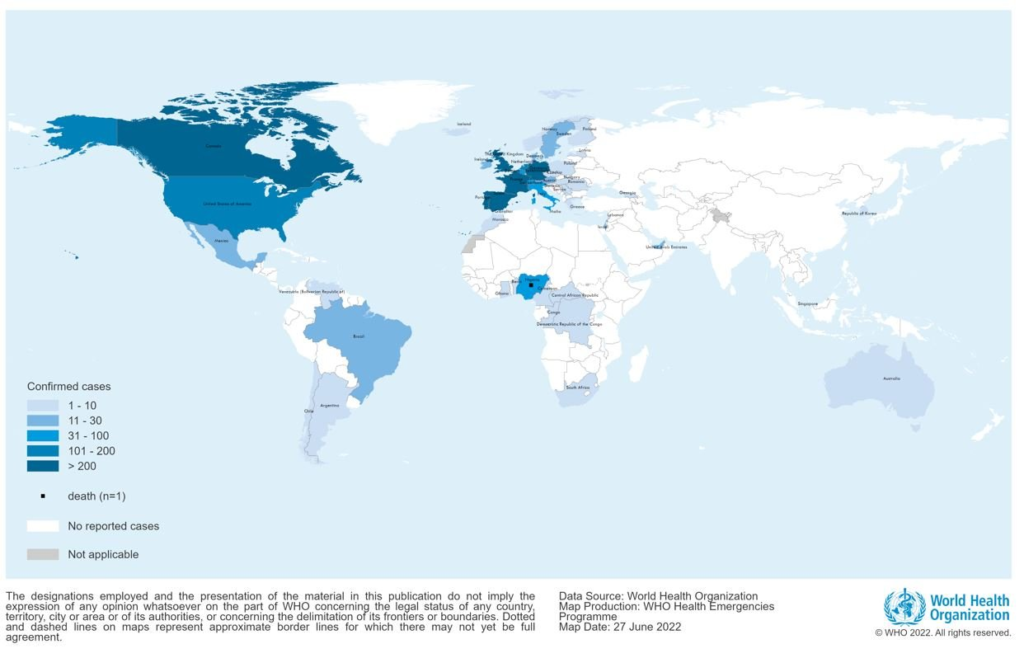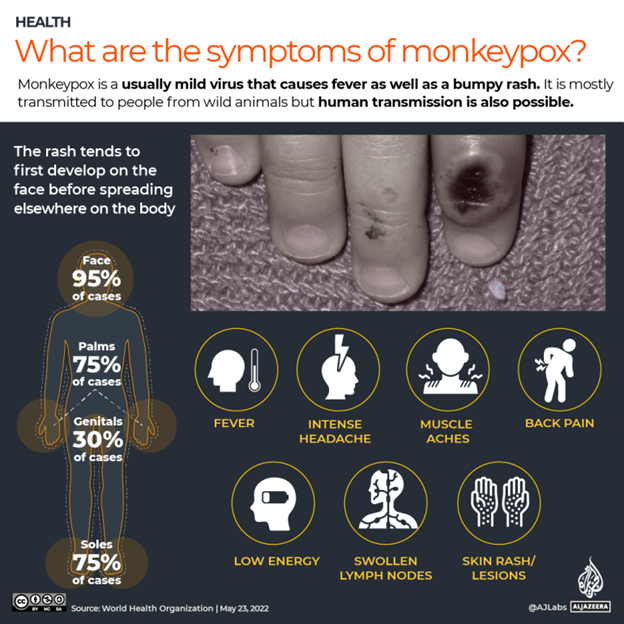As the world shifts its attention from COVID-19 to the global outbreak of monkeypox, here are some key facts to help understand and fight the virus.
What is monkeypox?
Monkeypox is a rare viral illness that typically involves flu-like symptoms, swelling of the lymph nodes, and a rash that includes bumps that are initially filled with fluid before scabbing over. Monkeypx is closely related to the smallpox virus and most infections typically lasting two to four weeks.1
Where did monkeypox come from?
It was discovered in 1958 when the pox-like illness was found in certain colonies of monkeys being used for research. The origin of the disease remains unknown. However, popular thought is that rodents and non-human primates like monkeys harbor the virus.2
The first human case of monkeypox occurred in 1970, and prior to the 2022 outbreak, its spread has been limited, with cases outside of Africa directly related to international travel.2
As of June 24, 2022, there are 4,106 cases identified worldwide, most of them in Western Europe, and 200 in the U.S; see map below.3

This is not the first time monkeypox has had an outbreak. There were previous outbreaks in 2001 and 2003, with less than 50 identified cases each. Researchers are unsure as to why the virus began to spread outside of Africa initially.3 The current outbreak is due to virus mutation, causing easier human-to-human spread, combined with super spreader events in Africa and international travel.4
How is monkeypox spread and what are its symptoms?
According to the CDC, monkeypox typically spreads through close contact.5 From the onset of symptoms until the rash fully heals, it can be spread in the following ways:
- Direct contact with the infectious rash, scabs, or body fluids
- Respiratory secretions during prolonged, face-to-face contact, or during intimate physical contact, such as kissing, cuddling, or sex
- Touching items (such as clothing or linens) that previously touched the infectious rash or body fluids
- Pregnant people can spread the virus to their fetus through the placenta
Fortunately, many people will have a mild, self-limiting disease, most treatment is symptomatic. Here is a timeline, to help provide a better idea of how the symptoms associated with exposure to monkeypox could play out:
- No symptoms: 1–2-week incubation period after exposure
- Early symptoms: 1-2 days following the exposure
- Malaise
- Fever
- No noticeable rash
- Ensuing symptoms: 1-2 weeks after fever
- Rash (flat, then fluid-filled bumps), starting on tongue, mouth, face, spreading to arms & legs & then all over body
- Final stage symptoms
- Pustules burst & scab over: 1-2 weeks
- Early symptoms: 1-2 days following the exposure

People at risk for more severe disease (severe rash, sepsis, encephalitis, etc.) include those who are immunocompromised, are less than 8 years of age, those who are pregnant or breastfeeding, and those with a history of skin conditions (eczema, psoriasis, severe acne, etc.).
What treatments are available for monkeypox?
There is no FDA-approved way to treat monkeypox, but there are some antiviral medications that can help.6 Off-label treatments are available for those with severe disease.6 Monkeypox is usually a mild illness and will get better by itself in a few weeks.
There have been no deaths associated with monkeypox in 2022 outside of Africa.3 There are two strains of monkeypox. West African strain has the milder disease, and this is the current strain in the 2022 outbreak.
Wellfleet follows CDC recommendations for vaccines. The CDC is not yet recommending the vaccine for anyone except “for prevention of smallpox and monkeypox disease in adults 18 years or older at high risk for smallpox or monkeypox infection” as noted below:6
- CDC recommends JYNNEOS™ for certain laboratory workers and emergency response team members who might be exposed to the viruses that cause orthopoxvirus infections.
- CDC recommends consideration of the vaccine for people who administer ACAM2000®, another type of smallpox vaccine, or who care for patients infected with orthopoxviruses.
If this outbreak continues to spread, the CDC may eventually expand its recommendation for the vaccine. At the current rate, this could occur in the fall/winter of 2022.
Monkeypox prevention
Due to the effects of the COVID-19 pandemic, many are worried about monkeypox and its potential spread. However, monkeypox is not like COVID-19. It would require sustained exposure and contact with an infected person before monkeypox is transmitted. It is recommended to be cautious, but not fearful.
Taking the following steps may help protect you from the monkeypox virus:
- Wear a mask and gloves
- Wash your hands regularly
- Practice social distancing when possible
If you have symptoms of monkeypox, you should talk to your healthcare provider, even if you do not think you had contact with someone who has monkeypox.
SOURCES
1 Louisiana Department of Health. (2022, July 12). Retrieved on July 15, 2022, from https://ldh.la.gov/news/monkeypox712.
2 CDC. (2022, July 12). About Monkeypox. Retrieved on July 15, 2022, from https://www.cdc.gov/poxvirus/monkeypox/about.html.
3WHO. (2022, June 27). Multi-country monkeypox outbreak: situation update. Retrieved on July 15, 2022, from https://www.who.int/emergencies/disease-outbreak-news/item/2022-DON396.
4 CIDRAP. (2022, June 24). Virus causing monkeypox outbreak has mutated to spread easier. Retrieved on July 15, 2022, from https://www.cidrap.umn.edu/news-perspective/2022/06/virus-causing-monkeypox-outbreak-has-mutated-spread-easier
5 CDC. (2022, June 24). How it spreads. Retrieved on July 15, 2022, from cdc.gov/poxvirus/monkeypox/transmission.html.
6 CDC. (2022, June 22). Treatment Information for Healthcare Professionals. Retrieved on July 15, 2022, from https://www.cdc.gov/poxvirus/monkeypox/clinicians/treatment.html.


